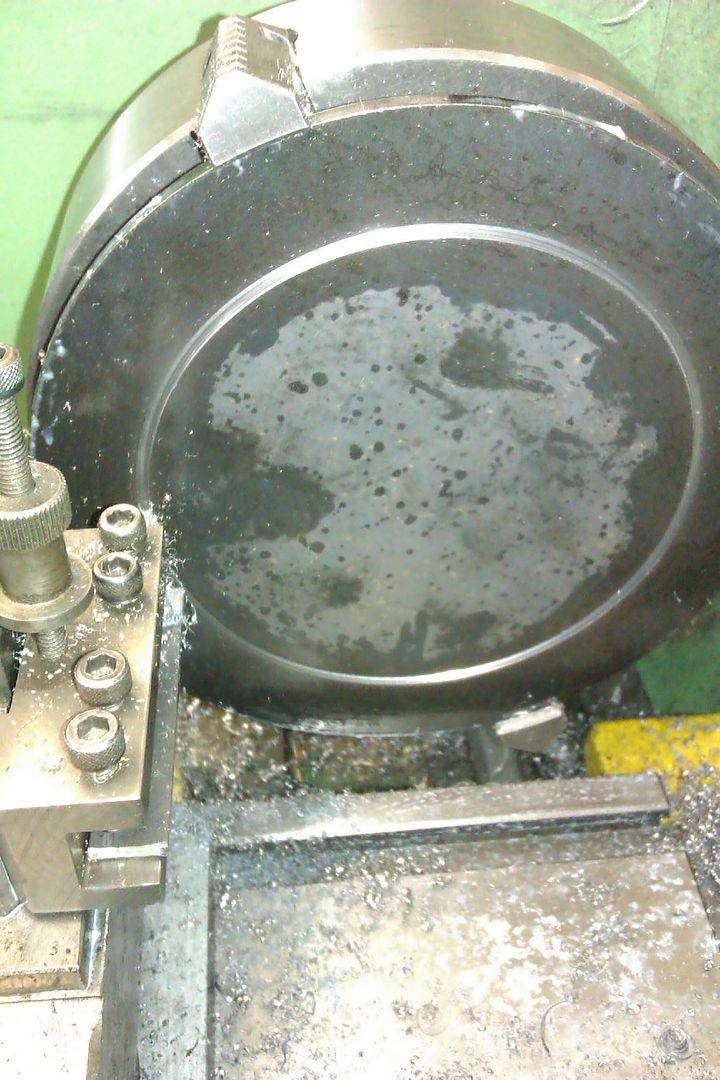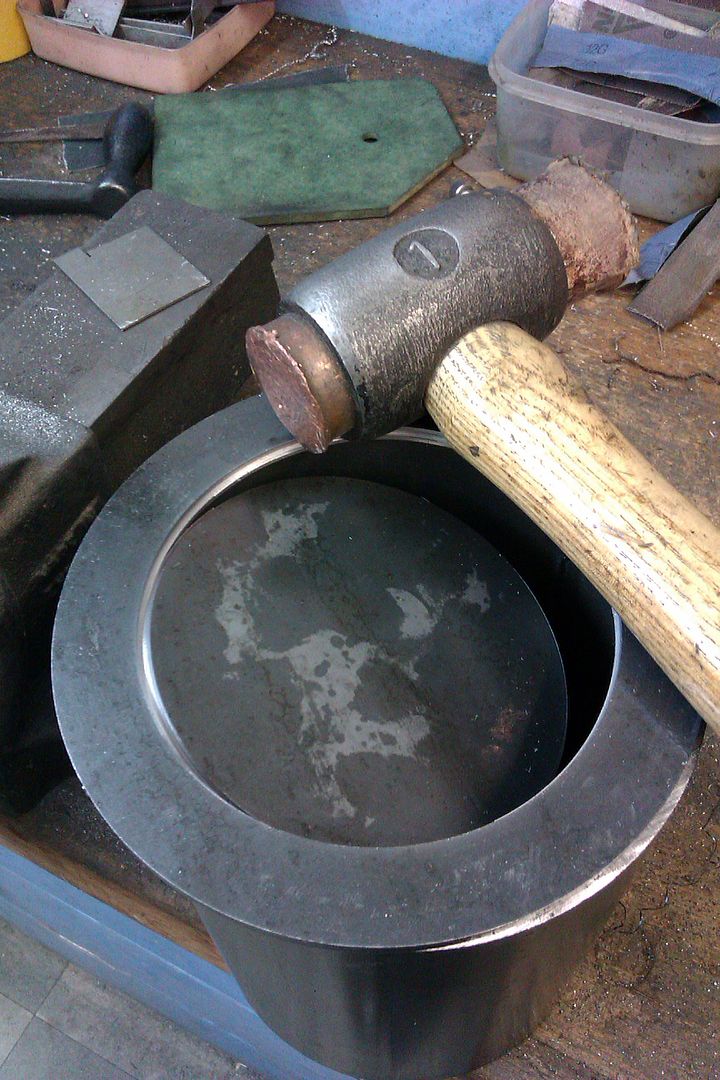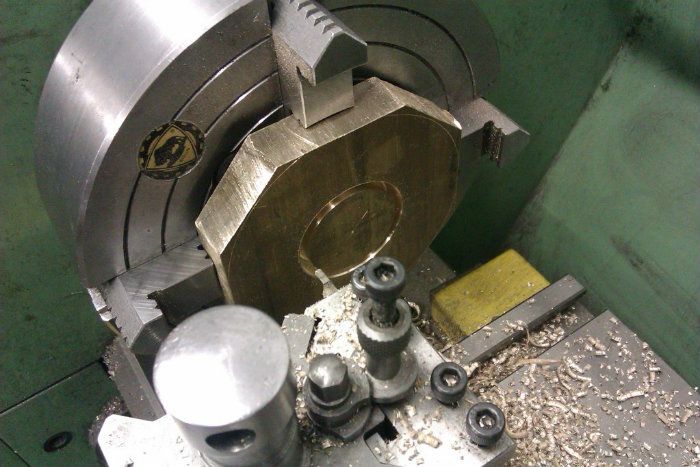Holesaws for steel
| Robin Graham | 13/04/2015 16:47:06 |
| 1089 forum posts 345 photos | Hi. I need to make a 1.75 inch hole centrally through a 1 inch thick slice of 3 inch EN1A round bar. Could drill and bore it out obviously, but wonder if the process could be speeded up by starting with a holesaw such as one of these ? Anyone tried something similar? Regards, Robin |
| Jon Gibbs | 13/04/2015 17:00:21 |
| 750 forum posts | Robin, I think you may need to keep withdrawing the holesaw to clean out the chips if drilling that deep. I've used holesaws for cutting holes in box section steel where they work just fine but would expect to have problems with swarf clogging up the teeth pretty quickly. HTH Jon |
| Tony Pratt 1 | 13/04/2015 17:12:02 |
| 2319 forum posts 13 photos | To be honest I would just crack on with a large drill & bore to size. Tony |
| Speedy Builder5 | 13/04/2015 17:12:26 |
| 2878 forum posts 248 photos | Why go to the expense of a hole saw, unless you didn't have a lathe. Centre drill and open up to 13mm ish then bore to size. |
| Enough! | 13/04/2015 17:18:50 |
| 1719 forum posts 1 photos | As Jon says, the major problem is tooth clogging once you get below tooth depth (i.e. almost immediately). You need to withdraw, flush/brush out very frequently - more so than you probably think - since it will clog again in a few revs. And as the slot deepens, getting the swarf out can be problematic. My own feeling is that it would be (much) quicker boring it especially if you have a decent carbide insert so that you can use fairly hefty cuts and feeds and you are boring all the way through the slice (with a reasonable clearance beyond) so that you don't have to be too fussy. |
| Capstan Speaking | 13/04/2015 18:09:16 |
177 forum posts 14 photos | It's too much for a hole saw to handle. It's probably best bored out. One inch is a long way. However I've done similar things by making a face plunging tool and trepanning it out. Cut the groove in the face a little wider than the tool.
|
| Robin Graham | 13/04/2015 19:13:38 |
| 1089 forum posts 345 photos | OK, thanks everyone. Looks like the holesaw idea is a non-starter, should have said I might have to do a few of these, so time is a factor, but I'll plod along with boring especially in view of the advice that it will be quicker anyway. I'm interested in the trepanning approach, but unsure about tool geometry - an admittedly cursory google search hasn't shown up anything other than a sort of one-tooth holesaw. Any pointers? Think this may have arisen before on this forum, but I can't find the thread now. Thanks again, Robin |
| Michael Gilligan | 13/04/2015 19:39:52 |
23121 forum posts 1360 photos | Posted by Robin Graham on 13/04/2015 19:13:38:
Think this may have arisen before on this forum, but I can't find the thread now. . Robin, You may ind something useful by trawling through these. MichaelG. |
| KWIL | 13/04/2015 19:54:12 |
| 3681 forum posts 70 photos | There is a cutter called Rotabroach, is like holesaw but with a different profile, intended for cutting through RSJs amongst other things. |
| Capstan Speaking | 13/04/2015 20:08:04 |
177 forum posts 14 photos | For background, a milling trepanning tool is here **LINK** . I'd make it have a square slide though. To trepan on a lathe you need a tool similar to a boring bar but facing towards the chuck. A round toolbit would do ground at the end down to the diameter with a top rake. Approach the face at just under the radius required and gradually plunge in. A circular groove is cut in the face. Open up the slot width slightly so it doesn't bind the tool and continue until nearly through. If the centre piece drops into the hole it may pinch the tool and snap it. It's best to knock the hole middle out at the last few thou. Those hole saw like tools are simply core drills and I don't like them especially the single tip ones. |
| Mark C | 13/04/2015 21:26:21 |
| 707 forum posts 1 photos | You can cut a hole through a 1 inch plate with a hole saw - I have done just that. I needed a 3 inch diameter hole in a thick plate on a job that was set on the mill, there was no way I was boring out from 1.25 inch (the biggest drill I have) and the saw was in the draw. they do clog up but if you keep the pressure on with plenty of cutting oil they clear surprisingly well up the sides (the teeth have a set to them). The one I used was a cheap one I got with some light fittings. Mark PS. keep the speed very slow! Edited By Mark C on 13/04/2015 21:30:44 |
| John McNamara | 14/04/2015 07:56:51 |
1377 forum posts 133 photos | Recently I cut some 80mm holes in 20mm Aluminium with a hole saw; I was after the disks for a job. I did it in the mill.. 5hp so no problem with power. I did quite a few and in the end it was very difficult to release the tool from the self tightening Drill chuck. In fact it had crushed the hex shank of the arbour that holds the hole saw. The mill has a 40int taper so positive engagement there no risk of scoring the taper in the mill arbour, I would not trust a Morse taper shank tool arbour to hold. unless it was pulled in by a draw bar. Ideally I should make up a special arbour and directly mount the hole saw on that... No drill chuck needed The larger size hole saws are driven by two pins, the screw just holds them in position. Yes you do end up doing a lot of pecking to clear the swarf. And slow RPM is good. For the aluminium I used CRC RP7 from a spray can as a lubricant. Oh... I normally let the hole saw float a tiny bit by screwing it right up on the arbour then releasing half a turn before dropping the pins in, this allows the saw to sit flat when it starts, they are not perfectly made often the blades are a bit off square to the axis. Now where is that bit of steel for the new arbour? Not that hard to turn and mill it does not have to be a ground finish, a good afternoons work. |
| Martin Kyte | 14/04/2015 08:25:16 |
3445 forum posts 62 photos | Just thinking outside the box really. It is usual to cut large hole through telescope mirrors (glass obviously) by the use of appropriate sized copper tube and grinding pasteThe copper tube is mounted in a drill press in a core drill configuration and has small saw cuts on the periphery. Grinding paste (slurry) is added and off the process goes. Essentially it's a lap as the grinding particles get embedded in the soft copper and do the cutting work. The trick is to get the wall size as thin as practicable so that the minimum of material is removed. It may just work for steel. regards Martin |
| JasonB | 14/04/2015 08:33:26 |
25215 forum posts 3105 photos 1 articles | Working up through to a 1" blacksmiths drill and then boring will likely be the quickest but if you want to trepan then come in from both sides to reduce tool overhang, leave a few thou in teh middle to retain teh waste then knock it out with a hammer.
|
| Steamer1915 | 14/04/2015 08:35:52 |
171 forum posts 42 photos | As KWIL says, a Rotabroach is the way to go, especially if you have a few to do. I use a 20mm dia for the initial hole in the dial bodies and backplate. The main advantage is that they only cut a 4-5mm annular groove so not all the "hole" is turned to swarf. Use coolant though. Steve. |
| andrew winks | 14/04/2015 11:32:32 |
117 forum posts 1 photos | Agreed, Rotabroach will punch through plate like butter. Used the magnetic clamp versions on 75mm plate, pour the coolant on and marvel at the ease with which these bits of kit do the job.
|
| Robin Graham | 14/04/2015 23:37:21 |
| 1089 forum posts 345 photos | Thanks for all your advice. Michael G - thanks to your post have finally got it into my thick head how to use Google to search specific sites, the search facility on this forum is pretty useless I have found. I shall follow up your link. Embarrassing really, I was once fluent in awk which I imagine has a more complex syntax than the Google search engine. The rotabroach looks good, but quite pricey - but I think it would make more sense for me to buy a beefier boring tool than I have now, and some blacksmith's drills. More versatile. To put my learning curve in this metal-mangling thing in context I have recently bought a 'big' lathe - something like a Chester Crusader. Previously I had only a Proxxon 400, which is a nice enough machine (about the size of a mini-lathe, but better made) but not very rigid, so no possibility of driving a 1" blacksmith's drill through steel. But I guess this new thing might be up to it. Still exploring what it can do. Thanks again for all your helpful suggestions, Rob.
|
| Paul Lousick | 15/04/2015 02:00:43 |
| 2276 forum posts 801 photos | I had to cut a 100mm dia hole in 10mm plate and used a 25mm Rota broach to step drill a series of holes to the rough shape for the hole. Then bored the hole to the finished size. Paul. |
| mark costello 1 | 15/04/2015 17:25:28 |
800 forum posts 16 photos | IF You could drill a small hole on the outer dimension of the intended hole it would give the chips a place to clear out. |
Please login to post a reply.
Want the latest issue of Model Engineer or Model Engineers' Workshop? Use our magazine locator links to find your nearest stockist!
Sign up to our newsletter and get a free digital issue.
You can unsubscribe at anytime. View our privacy policy at www.mortons.co.uk/privacy
- hemingway ball turner
04/07/2025 14:40:26 - *Oct 2023: FORUM MIGRATION TIMELINE*
05/10/2023 07:57:11 - Making ER11 collet chuck
05/10/2023 07:56:24 - What did you do today? 2023
05/10/2023 07:25:01 - Orrery
05/10/2023 06:00:41 - Wera hand-tools
05/10/2023 05:47:07 - New member
05/10/2023 04:40:11 - Problems with external pot on at1 vfd
05/10/2023 00:06:32 - Drain plug
04/10/2023 23:36:17 - digi phase converter for 10 machines.....
04/10/2023 23:13:48 - More Latest Posts...
- View All Topics
- Reeves** - Rebuilt Royal Scot by Martin Evans
by John Broughton
£300.00 - BRITANNIA 5" GAUGE James Perrier
by Jon Seabright 1
£2,500.00 - Drill Grinder - for restoration
by Nigel Graham 2
£0.00 - WARCO WM18 MILLING MACHINE
by Alex Chudley
£1,200.00 - MYFORD SUPER 7 LATHE
by Alex Chudley
£2,000.00 - More "For Sale" Ads...
- D1-3 backplate
by Michael Horley
Price Not Specified - fixed steady for a Colchester bantam mark1 800
by George Jervis
Price Not Specified - lbsc pansy
by JACK SIDEBOTHAM
Price Not Specified - Pratt Burnerd multifit chuck key.
by Tim Riome
Price Not Specified - BANDSAW BLADE WELDER
by HUGH
Price Not Specified - More "Wanted" Ads...
Do you want to contact the Model Engineer and Model Engineers' Workshop team?
You can contact us by phone, mail or email about the magazines including becoming a contributor, submitting reader's letters or making queries about articles. You can also get in touch about this website, advertising or other general issues.
Click THIS LINK for full contact details.
For subscription issues please see THIS LINK.
Model Engineer Magazine
- Percival Marshall
- M.E. History
- LittleLEC
- M.E. Clock
ME Workshop
- An Adcock
- & Shipley
- Horizontal
- Mill
Subscribe Now
- Great savings
- Delivered to your door
Pre-order your copy!
- Delivered to your doorstep!
- Free UK delivery!














 Register
Register Log-in
Log-in


